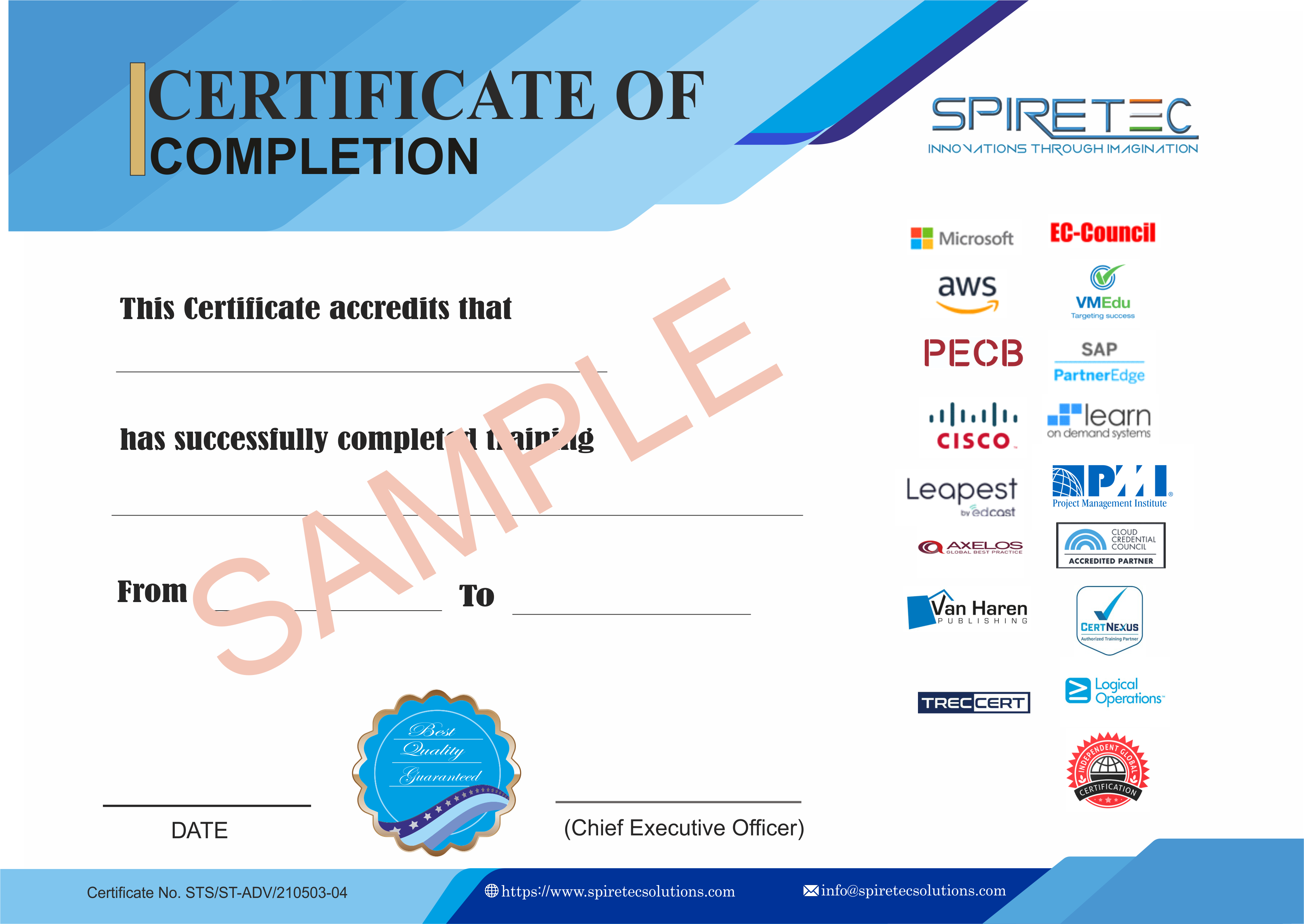The CISSP course provides a comprehensive understanding of information security, covering essential topics across eight domains:
-
Security and Risk Management
-
Asset Security
-
Security Architecture and Engineering
-
Communication and Network Security
-
Identity and Access Management (IAM)
-
Security Assessment and Testing
-
Security Operations
-
Software Development Security
Participants will learn about confidentiality, integrity, and availability, as well as security governance, legal and regulatory issues. The course emphasizes developing security policies, managing risks, and implementing business continuity strategies. Completing the CISSP certification demonstrates high competency in the field of information security.
Course Prerequisites
To succeed in the CISSP course, students should:
-
Have a basic understanding of information security principles.
-
Be familiar with IT security concepts such as confidentiality, integrity, and availability.
-
Have knowledge of computer networks and security controls.
-
Be experienced in IT governance and risk management.
-
Understand relevant legal and regulatory requirements.
-
Know business continuity and disaster recovery principles.
-
Be aware of security protocols and authentication methods.
-
Comprehend data lifecycle management practices.
-
Have experience with security software and hardware tools.
-
Practical experience in IT or information security is beneficial but not mandatory.
Target Audience
The course is designed for:
-
Information Security Analysts
-
Security Managers
-
IT Auditors
-
Security Architects
-
Network Architects
-
Security Systems Engineers
-
Chief Information Security Officers (CISOs)
-
IT Directors/Managers
-
Security Consultants
-
Risk Management Professionals
-
Systems Administrators
-
Government or military IT professionals with security duties
-
Security Auditors
-
Security Software Developers
-
Forensics Analysts
-
Business Continuity and Disaster Recovery Specialists
-
Compliance Officers
-
Privacy Officers
-
Legal Professionals with information security responsibilities
-
Security training and education professionals
-
Technical Support Engineers involved in security system maintenance
-
Incident Responders and Crisis Managers
Learning Objectives
Participants will:
-
Apply confidentiality, integrity, and availability concepts to maintain security.
-
Implement security governance and compliance measures.
-
Develop and document security policies, standards, and procedures.
-
Prioritize and address business continuity requirements.
-
Apply risk management methodologies to reduce threats.
-
Use secure design principles for system and data protection.
-
Manage identity and access through effective practices.
-
Design and conduct security assessments and tests.
-
Perform logging, monitoring, and incident management.
-
Integrate security best practices into the Software Development Life Cycle (SDLC).
Course Outline
1) The Information Security Environment
-
Justify an organizational code of ethics
-
Relate confidentiality, integrity, availability, non-repudiation, authenticity, privacy and safety to due care and due diligence
-
Relate information security governance to organizational business strategies, goals, missions, and objectives
-
Apply the concepts of cybercrime to data breaches and other information security compromises
-
Relate legal, contractual, and regulatory requirements for privacy and data protection to information security objectives
-
Relate transborder data movement and import-export issues to data protection, privacy, and intellectual property protection
2) Information Asset Security
-
Relate the IT asset management and data security lifecycle models to information security
-
Explain the use of information classification and categorization, as two separate but related processes
-
Describe the different data states and their information security considerations
-
Describe the different roles involved in the use of information, and the security considerations for these roles
-
Describe the different types and categories of information security controls and their use
-
Select data security standards to meet organizational compliance requirements
3) Identity and Access Management (IAM)
-
Explain the identity lifecycle as it applies to human and nonhuman users
-
Compare and contrast access control models, mechanisms, and concepts
-
Explain the role of authentication, authorization, and accounting in achieving information security goals and objectives
-
Explain how IAM implementations must protect physical and logical assets
-
Describe the role of credentials and the identity store in IAM systems
4) Security Architecture and Engineering
-
Describe the major components of security engineering standards
-
Explain major architectural models for information security
-
Explain the security capabilities implemented in hardware and firmware
-
Apply security principles to different information systems architectures and their environments
-
Determine the best application of cryptographic approaches to solving organizational information security needs
-
Manage the use of certificates and digital signatures to meet organizational information security needs
-
Discover the implications of the failure to use cryptographic techniques to protect the supply chain
-
Apply different cryptographic management solutions to meet the organizational information security needs
-
Verify cryptographic solutions are working and meeting the evolving threat of the real world
-
Describe defenses against common cryptographic attacks
-
Develop a management checklist to determine the organization’s cryptologic state of health and readiness
5) Communication and Network Security
-
Describe the architectural characteristics, relevant technologies, protocols and security considerations of each of the layers in the OSI model
-
Explain the application of secure design practices in developing network infrastructure
-
Describe the evolution of methods to secure IP communications protocols
-
Explain the security implications of bound (cable and fiber) and unbound (wireless) network environments
-
Describe the evolution of, and security implications for, key network devices
-
Evaluate and contrast the security issues with voice communications in traditional and VoIP infrastructures
-
Describe and contrast the security considerations for key remote access technologies
-
Explain the security implications of software-defined networking (SDN) and network virtualization technologies
6) Software Development Security
-
Recognize the many software elements that can put information systems security at risk
-
Identify and illustrate major causes of security weaknesses in source code
-
Illustrate major causes of security weaknesses in database and data warehouse systems
-
Explain the applicability of the OWASP framework to various web architectures
-
Select malware mitigation strategies appropriate to organizational information security needs
-
Contrast the ways that different software development methodologies, frameworks, and guidelines contribute to systems security
-
Explain the implementation of security controls for software development ecosystems
-
Choose an appropriate mix of security testing, assessment, controls, and management methods for different systems and applications environments
7) Security Assessment and Testing
-
Describe the purpose, process, and objectives of formal and informal security assessment and testing
-
Apply professional and organizational ethics to security assessment and testing
-
Explain internal, external, and third-party assessment and testing
-
Explain management and governance issues related to planning and conducting security assessments
-
Explain the role of assessment in data-driven security decision-making
8) Security Operations
-
Show how to efficiently and effectively gather and assess security data
-
Explain the security benefits of effective change management and change control
-
Develop incident response policies and plans
-
Link incident response to needs for security controls and their operational use
-
Relate security controls to improving and achieving required availability of information assets and systems
-
Understand the security and safety ramifications of various facilities, systems, and infrastructure characteristics
9) Putting It All Together
-
Explain how governance frameworks and processes relate to the operational use of information security controls
-
Relate the process of conducting forensic investigations to information security operations
-
Relate business continuity and disaster recovery preparedness to information security operations
-
Explain how to use education, training, awareness, and engagement with all members of the organization as a way to strengthen and enforce information security processes
-
Show how to operationalize information systems and IT supply chain risk management











 Live Online Training (Duration : 40 Hours)
Live Online Training (Duration : 40 Hours)
